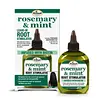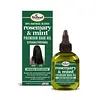What's inside
What's inside
 Key Ingredients
Key Ingredients

 Benefits
Benefits

 Concerns
Concerns

 Ingredients Side-by-side
Ingredients Side-by-side

Water
Skin ConditioningAlcohol Denat.
AntimicrobialGlycerin
HumectantNiacinamide
SmoothingRosmarinus Officinalis Leaf Oil
MaskingMentha Piperita Oil
MaskingMentha Arvensis Leaf Oil
MaskingOcimum Basilicum Hairy Root Culture Extract
Skin ConditioningAllantoin
Skin ConditioningPanthenol
Skin ConditioningSodium PCA
HumectantArginine
MaskingAspartic Acid
MaskingGlycine
BufferingAlanine
MaskingSerine
MaskingValine
MaskingProline
Skin ConditioningThreonine
Isoleucine
Skin ConditioningHistidine
HumectantPhenylalanine
MaskingSodium Lactate
BufferingHydrolyzed Corn Protein
Skin ConditioningHydrolyzed Soy Protein
HumectantHydrolyzed Wheat Protein
Skin ConditioningHydroxypropyl Bis-Hydroxyethyldimonium Chloride
HumectantXanthan Gum
EmulsifyingMenthol
MaskingPropanediol
SolventCitric Acid
BufferingCaprylhydroxamic Acid
Polysorbate 20
EmulsifyingAlcohol
AntimicrobialTetrasodium Glutamate Diacetate
Parfum
MaskingLimonene
PerfumingLinalool
PerfumingBenzyl Salicylate
PerfumingEugenol
PerfumingCoumarin
PerfumingCitronellol
PerfumingCitral
PerfumingWater, Alcohol Denat., Glycerin, Niacinamide, Rosmarinus Officinalis Leaf Oil, Mentha Piperita Oil, Mentha Arvensis Leaf Oil, Ocimum Basilicum Hairy Root Culture Extract, Allantoin, Panthenol, Sodium PCA, Arginine, Aspartic Acid, Glycine, Alanine, Serine, Valine, Proline, Threonine, Isoleucine, Histidine, Phenylalanine, Sodium Lactate, Hydrolyzed Corn Protein, Hydrolyzed Soy Protein, Hydrolyzed Wheat Protein, Hydroxypropyl Bis-Hydroxyethyldimonium Chloride, Xanthan Gum, Menthol, Propanediol, Citric Acid, Caprylhydroxamic Acid, Polysorbate 20, Alcohol, Tetrasodium Glutamate Diacetate, Parfum, Limonene, Linalool, Benzyl Salicylate, Eugenol, Coumarin, Citronellol, Citral
Glycine Soja Oil
EmollientCanola Oil
EmollientParfum
MaskingRosmarinus Officinalis Leaf Oil
MaskingMentha Piperita Oil
MaskingMentha Arvensis Leaf Oil
MaskingRicinus Communis Seed Oil
MaskingPrunus Amygdalus Dulcis Oil
Skin ConditioningLimnanthes Alba Seed Oil
Skin ConditioningHelianthus Annuus Seed Oil
EmollientCucumis Sativus Fruit Extract
EmollientOlea Europaea Leaf Extract
PerfumingEucalyptus Globulus Leaf Extract
PerfumingHypericum Perforatum Flower/Leaf/Stem Extract
Skin ConditioningRosa Canina Fruit Extract
AstringentCitrus Grandis Peel Extract
AstringentSalix Alba Bark Extract
AstringentMenthol
MaskingBHT
AntioxidantAmyl Cinnamal
PerfumingHexyl Cinnamal
PerfumingLinalool
PerfumingLimonene
PerfumingCoumarin
PerfumingCitronellol
PerfumingIsoeugenol
PerfumingEugenol
PerfumingCitral
PerfumingGlycine Soja Oil, Canola Oil, Parfum, Rosmarinus Officinalis Leaf Oil, Mentha Piperita Oil, Mentha Arvensis Leaf Oil, Ricinus Communis Seed Oil, Prunus Amygdalus Dulcis Oil, Limnanthes Alba Seed Oil, Helianthus Annuus Seed Oil, Cucumis Sativus Fruit Extract, Olea Europaea Leaf Extract, Eucalyptus Globulus Leaf Extract, Hypericum Perforatum Flower/Leaf/Stem Extract, Rosa Canina Fruit Extract, Citrus Grandis Peel Extract, Salix Alba Bark Extract, Menthol, BHT, Amyl Cinnamal, Hexyl Cinnamal, Linalool, Limonene, Coumarin, Citronellol, Isoeugenol, Eugenol, Citral
Ingredients Explained
These ingredients are found in both products.
Ingredients higher up in an ingredient list are typically present in a larger amount.
Citral is a fragrance and used to add a lemon-like scent to products. It is both naturally found in plants and created synthetically. In plants, it is commonly occurring in lemon myrtle, lemongrass, lemon tea-tree, lemon verbena, and other citruses.
The EU mandates Citral be listed separately as a fragrance. It is a known allergen and may cause contact dermatitis. Citral can also used as a masking ingredient.
The term 'fragrance' is not regulated in many countries. In many cases, it is up to the brand to define this term. For instance, many brands choose to label themselves as "fragrance-free" because they are not using synthetic fragrances. However, their products may still contain ingredients such as essential oils that are considered a fragrance.
The term 'citral' is a collective term for two geometric isomers: geranial/Citral A and neral/Citral B.
Learn more about CitralCitronellol is used to add fragrance/parfum to a product. It is often derived from plants such as roses. In fact, it can be found in many essential oils including geranium, lavender, neroli, and more. The scent of Citronellol is often described as "fresh, grassy, and citrus-like".
Since the Citronellol molecule is already unstable, Citronellol becomes irritating on the skin when exposed to air.
Citronellol is a modified terpene. Terpenes are unsaturated hydrocarbons found in plants. They make up the primary part of essential oils.
Citronellol is not able to be absorbed into deeper layers of the skin. It has low permeability,
Citronellol is also a natural insect repellent.
Learn more about CitronellolCoumarins are a group of substances found naturally in plants. There are over 1300 types of coumarins identified. It has a natural vanilla scent.
Coumarin is an identified EU known allergy, meaning it may cause an allergic reaction when applied to the skin.
In many countries, coumarin is banned as a food additive. However, it can be found in soaps, tobacco products, and some alcohol drinks.
Plants use coumarins as a chemical defense. Some plants that have coumarins include lavender, tonka beans, and yellow clovers.
Learn more about CoumarinEugenol is naturally found in cloves, basil, and bay leaves. It is an aromatic oil used to add fragrance to a product. The scent of eugenol is described as "clove-like". Eugenol is a known EU allergen, meaning it causes contact allergies.
Studies show eugenol possesses antibacterial and antioxidant properties.
Besides cosmetics, eugenol is also added as a flavor in teas and cakes.
Learn more about EugenolLimonene is a fragrance that adds scent and taste to a formulation.
It's found in the peel oil of citrus fruits and other plants such as lavender and eucalyptus. The scent of limonene is generally described as "sweet citrus".
Limonene acts as an antioxidant, meaning it helps neutralize free radicals.
When exposed to air, oxidized limonene may sensitize the skin. Because of this, limonene is often avoided by people with sensitive skin.
The term 'fragrance' is not regulated in many countries. In many cases, it is up to the brand to define this term. For instance, many brands choose to label themselves as "fragrance-free" because they are not using synthetic fragrances. However, their products may still contain ingredients such as essential oils that are considered a fragrance.
Learn more about LimoneneLinalool is a fragrance and helps add scent to products. It's derived from common plants such as cinnamon, mint, citrus, and lavender.
Like Limonene, this ingredient oxidizes when exposed to air. Oxidized linalool can cause allergies and skin sensitivity.
This ingredient has a scent that is floral, spicy tropical, and citrus-like.
Learn more about LinaloolMentha Arvensis Leaf Oil is an oil.
Mentha Piperita Oil is the volatile oil obtained from the whole plant of the Peppermint plant.
It can be used to add a fresh scent to products.
Peppermint oil may cause skin sensitivity and redness due to its menthol content. Menthol also has a cooling effect (like your toothpaste).
Learn more about Mentha Piperita OilMenthol is a compound found in mint plants, such as peppermint. In its pure form, it is a clear crystalline substance.
Menthol is known for its cooling sensation; however, the cooling is actually from your skin being sensitized. Menthol can worsen rosacea. We recommend speaking with a professional if you have concerns.
Menthol also has antimicrobial properties.
Learn more about MentholParfum is a catch-all term for an ingredient or more that is used to give a scent to products.
Also called "fragrance", this ingredient can be a blend of hundreds of chemicals or plant oils. This means every product with "fragrance" or "parfum" in the ingredients list is a different mixture.
For instance, Habanolide is a proprietary trade name for a specific aroma chemical. When used as a fragrance ingredient in cosmetics, most aroma chemicals fall under the broad labeling category of “FRAGRANCE” or “PARFUM” according to EU and US regulations.
The term 'parfum' or 'fragrance' is not regulated in many countries. In many cases, it is up to the brand to define this term.
For instance, many brands choose to label themselves as "fragrance-free" because they are not using synthetic fragrances. However, their products may still contain ingredients such as essential oils that are considered a fragrance by INCI standards.
One example is Calendula flower extract. Calendula is an essential oil that still imparts a scent or 'fragrance'.
Depending on the blend, the ingredients in the mixture can cause allergies and sensitivities on the skin. Some ingredients that are known EU allergens include linalool and citronellol.
Parfum can also be used to mask or cover an unpleasant scent.
The bottom line is: not all fragrances/parfum/ingredients are created equally. If you are worried about fragrances, we recommend taking a closer look at an ingredient. And of course, we always recommend speaking with a professional.
Learn more about ParfumRosmarinus Officinalis Leaf Oil is oil expressed from the leaves of the rosemary plant.
Rosemary Leaf Oil is a fragrance and helps give your product a scent. If you are sensitive to irritating fragrances, this one contains camphor. Camphor has been found to irritate skin.
This oil also contains antioxidant and antimicrobial properties. As an antioxidant, it may protect you skin against damage. This can help slow down the signs of aging.
Learn more about Rosmarinus Officinalis Leaf Oil